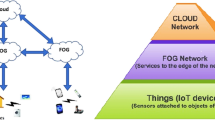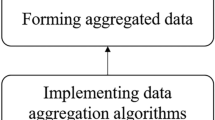Abstract
Due to the big data exchange on the Internet of Things, proper routing and selecting the best routes for fast data transmission improve network performance. There are major challenges, like high delay, when cloud computing is used. Therefore, one solution is to use other schemes, such as fog computing. In fog computing, all data is not sent to the cloud and the fog nodes close to objects are used for data processing. This reduces the network delay. In this paper, we propose an overlapping clustering method called MFCT-IoT to select the best cluster head nodes to guarantee the fast data transfer from objects to fog nodes. The selected cluster head nodes are responsible for sending the collected data to the closest fog nodes in the network edge. Upon receiving the data, the fog nodes process it, and if a response is ready, they respond immediately to the object. Otherwise, they merge and transmit the data to the cloud servers, which are considered as the root node of the proposed hierarchical tree. After processing, the merged data is sent to the object. We compare the proposed scheme with two schemes, including ERGID and EECRP. These schemes are evaluated based on various criteria, including the response time, packet delivery ratio, end-to-end delay, network lifetime, and energy consumption. The results indicate that the proposed method outperforms others in terms of all criteria.









Similar content being viewed by others
References
Qadri YA, Amjad M, Zikria YB, Afzal MK, Kim SW (2020) Multimedia Internet of Things: a comprehensive survey. IEEE Access 8:8202–8250
Tewari, A., & Gupta, B. B. (2020). Security, privacy and trust of different layers in Internet-of-Things (IoTs) framework. Future generation computer systems, 108, 909–920
Samie, F., Bauer, L. and Henkel, J., 2019. From cloud down to things: An overview of machine learning in internet of things. IEEE Internet of Things Journal, 6(3), pp. 4921–4934
Banijamali A, Pakanen OP, Kuvaja P, Oivo M (2020) Software architectures of the convergence of cloud computing and the Internet of Things: A systematic literature review. Information and Software Technology 122:106271
Tange, K., De Donno, M., Fafoutis, X. and Dragoni, N., 2020. A systematic survey of industrial internet of things security: Requirements and fog computing opportunities. IEEE Communications Surveys & Tutorials, 22(4), pp. 2489–2520
Javadzadeh, G. and Rahmani, A.M., 2020. Fog computing applications in smart cities: A systematic survey. Wireless Networks, 26(2), pp. 1433–1457
Bharti M and Jindal H (2020) Optimized clustering-based discovery framework on internet of things. J Supercomput 77, 1739–1778
Guo, X., Lin, H., Wu, Y. and Peng, M., 2020. A new data clustering strategy for enhancing mutual privacy in healthcare IoT systems. Future Generation Computer Systems, 113, pp. 407–417
Asensio A, Masip-Bruin X, Durán RJ, de Miguel I, Ren G, Daijavad S and Jukan A (2020) Designing an efficient clustering strategy for combined Fog-to-Cloud scenarios. Future Gener Comput Syst 109:392–406
Ever, E., Shah, P., Mostarda, L., Omondi, F. and Gemikonakli, O., 2019. On the performance, availability and energy consumption modelling of clustered IoT systems. Computing, 101(12), pp. 1935–1970
Liu, C., Nitschke, P., Williams, S.P. and Zowghi, D., 2020. Data quality and the Internet of Things. Computing, 102(2), pp. 573–599
Barolli L, Hussain F, Takizawa M (2021) Special issue on intelligent edge, fog, cloud and Internet of Things (IoT)-based services
Swarna Priya, R.M., Bhattacharya, S., Maddikunta, P.K.R., Somayaji, S.R.K., Lakshmanna, K., Kaluri, R., Hussien, A. and Gadekallu, T.R. (2020) Load balancing of energy cloud using wind driven and firefly algorithms in internet of everything. J Parallel Distrib Comput 142:16–26
Mohindru G, Mondal K, Banka H (2020) Internet of Things and data analytics: A current review. Wiley Interdisciplinary Reviews: Data Mining and Knowledge Discovery 10(3):e1341
Marietta, J., & Mohan, B. C. (2020). A review on routing in internet of things. Wireless Personal Communications, 111(1), 209–233
Hao Y, Yeh TCJ, Gao Z, Wang Y, Zhao Y (2006) A gray system model for studying the response to climatic change: The Liulin karst springs, China. J Hydrol 328(3–4):668–676
Qiu T, Zheng K, Han M, Chen CP, Xu M (2017) A data-emergency-aware scheduling scheme for Internet of Things in smart cities. IEEE Trans Indstr Inf 14(5):2042–2051
Sobral JV, Rodrigues JJ, Rabêo RA, Saleem K, Furtado V (2019) LOADng-IoT: an enhanced routing protocol for Internet of Things applications over low power networks. Sensors 19(1):150
Perkins CE, Royer EM (1999) Ad-hoc on-demand distance vector routing. In: Proceedings WMCSA’99. Second IEEE workshop on mobile computing systems and applications. IEEE, pp 90–100
Rahbari, D., & Nickray, M. (2020). Task offloading in mobile fog computing by classification and regression tree. Peer-to-Peer Networking and Applications, 13(1), 104–122
Naranjo, P. G. V., Shojafar, M., Mostafaei, H., Pooranian, Z., & Baccarelli, E. (2017). P-SEP: A prolong stable election routing algorithm for energy-limited heterogeneous fog-supported wireless sensor networks. The Journal of Supercomputing, 73(2), 733–755
Borujeni, E. M., Rahbari, D., & Nickray, M. (2018). Fog-based energy-efficient routing protocol for wireless sensor networks. The Journal of Supercomputing, 74(12), 6831–6858
Lindsey S, Raghavendra CS (2002) PEGASIS: power-efficient gathering in sensor information systems. In: Proceedings, IEEE aerospace conference, vol 3. IEEE, pp 3–3
Kar P, Misra S (2017) Detouring dynamic routing holes in stationary wireless sensor networks in the presence of temporarily misbehaving nodes. International Journal of Communication Systems 30(4):e3009
Iwendi, C., Maddikunta, P. K. R., Gadekallu, T. R., Lakshmanna, K., Bashir, A. K., & Piran, M. J. (2020). A metaheuristic optimization approach for energy efficiency in the IoT networks. Softw Pract Exp 51: 2558–2571
Chandnani N, Khairnar CN (2020) A comprehensive review and performance evaluation of recent trends for data aggregation and routing techniques in IoT networks. In: Social networking and computational intelligence. Springer, Singapore, pp 467–484
Zhu, M., Chang, L., Wang, N., & You, I. (2020). A smart collaborative routing protocol for delay sensitive applications in industrial IoT. IEEE Access, 8, 20413–20427
Jin, Y., Gormus, S., Kulkarni, P., & Sooriyabandara, M. (2016). Content centric routing in IoT networks and its integration in RPL. Computer Communications, 89, 87–104
Qiu, T., Lv, Y., Xia, F., Chen, N., Wan, J., & Tolba, A. (2016). ERGID: An efficient routing protocol for emergency response Internet of Things. Journal of Network and Computer Applications, 72, 104–112
Shen, J., Wang, A., Wang, C., Hung, P. C., & Lai, C. F. (2017). An efficient centroid-based routing protocol for energy management in WSN-assisted IoT. Ieee Access, 5, 18469–18479
Pakkar, M.S., 2016. Multiple attribute grey relational analysis using DEA and AHP. Complex & Intelligent Systems, 2(4), pp. 243–250
Author information
Authors and Affiliations
Corresponding author
Additional information
Publisher's Note
Springer Nature remains neutral with regard to jurisdictional claims in published maps and institutional affiliations.
Rights and permissions
About this article
Cite this article
Akbari, M.R., Barati, H. & Barati, A. An efficient gray system theory-based routing protocol for energy consumption management in the Internet of Things using fog and cloud computing. Computing 104, 1307–1335 (2022). https://doi.org/10.1007/s00607-021-01048-z
Received:
Accepted:
Published:
Issue Date:
DOI: https://doi.org/10.1007/s00607-021-01048-z




